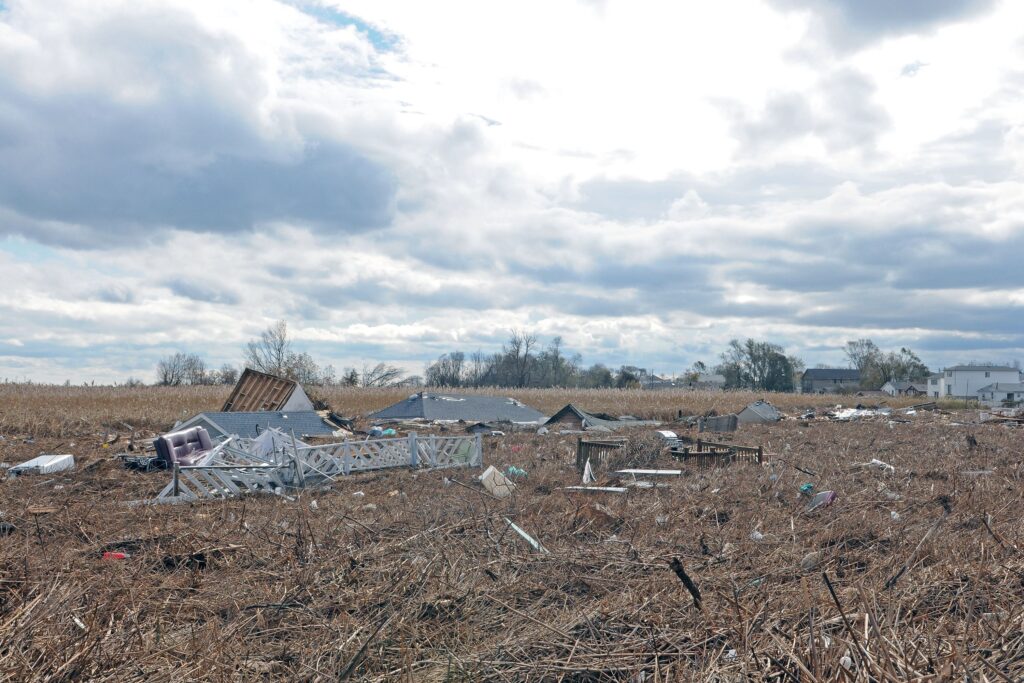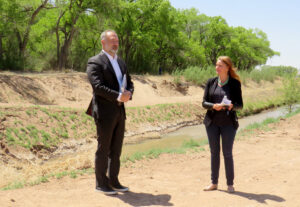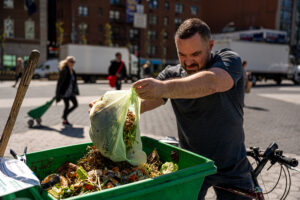City Eyes New Push to Buy Out Flood-Prone Houses as Climate Change Hits Home

When Patricia Snyder’s oceanside bungalow was demolished, relief washed over her like a wave.
The then-resident of Oakwood Beach, Staten Island, knew she wouldn’t have to ever again deal with what she’d endured due to Superstorm Sandy. The storm brought six feet of water into home and led to the drowning of her brother, Leonard, who lived nearby.
Her home — and those of her daughter and her brother — were three of the hundreds of damaged houses the state agreed to pay for and knock down in Staten Island in the wake of Sandy, which made landfall in the city on Oct. 29, 2012.
“The majority of the neighborhood decided they were done with it, tired of their restless nights worrying about high tides, all of that,” Snyder said.
Now she and her husband live less than two miles from where their former house stood, in a home they moved into about a year after Sandy hit.
Her daughter took the buyout and moved to Pennsylvania with her kids, which means Snyder doesn’t see her grandchildren as much as she’d like. And Snyder misses the quiet of the beach and close-knit community.
But she wouldn’t go back to her old neighborhood.
‘Housing Mobility’ on Tap
Spurred by Sandy, the state’s buyout program — as well as the city’s more limited version — was unprecedented for the area at the time.
Since then, the practice has been on the back-burner when it comes to resiliency efforts.
But now, amid some calls for buyouts for Queens residents who have long experienced frequent flooding — underscored by the record rain brought last month by remnants of Hurricane Ida — the city may be inching towards another program.
Jainey Bavishi, director of the Mayor’s Office of Climate Resilience, told the City Council last week that the administration is asking Congress for funding for a possible voluntary buyout program.
In an interview earlier this month with THE CITY, Bavishi said that any climate-minded “housing mobility” program should be “explored in conversation with New Yorkers, based on individual risk tolerance.”
“There’s a lot more work to do to explore what this looks like and how it plays out in our city,” she said. “We can start these conversations with New Yorkers and be intentional and proactive and have a lead time to take intentional steps, rather than react to a disaster or be displaced because we have policies that are forcing displacement or financial impact New Yorkers can’t afford.”
Bavishi’s office is conducting outreach to learn how to best meet the needs of the most vulnerable New Yorkers before engaging in planning and policymaking, according to Michael McCann, a climate adaptation specialist with The Nature Conservancy, which is teaming up with the city on the effort.
A Hard Sell
Buyouts and acquisitions are forms of a climate change adaptation strategy known as managed retreat, in which people, buildings and other infrastructure are moved away from risks, such as coastal or inland flooding.
In both cases, governments purchase property from homeowners. In buyouts, the property is returned to nature, not to be developed. Acquisitions, on the other hand, can lead to future development that is, at least theoretically, more resilient.
After Ida, some residents in Queens who have experienced repeated flooding — and still await governmental aid — have inquired about possible buyouts or acquisitions.
Councilmember Peter Koo, whose district includes Flushing, said he’s heard many homeowners who have asked for the city to purchase their houses and transform the properties into green space.
“Right now, it’s really hard for them to sell their houses,” Koo said. “If the city bought their houses, they would have the money to move somewhere else. They don’t want to live in the same place. Every time it rains, they worry.”
Amrita Bhagwandin, 52, is one of the several residents of low-lying Hollis, Queens, who want the city to buy them out. She’s been staying with her sister-in-law and in a hotel provided by the Red Cross since remnants from Hurricane Ida deluged her home.
“I love this place. It’s very diversified. I feel very much at home here,” she said. But after facing repeated flooding over the years, Bhagwandin would rather move somewhere drier.
“This is my home. I’ve invested everything in it. I’ve paid a lot of money for it … and I have cleaned it up and rebuilt it so many times,” she said. “I want some accountability from the city for this.”
‘The Bottom of a Pit’
Her neighbor Anita Hack, 53, a receptionist who’s lived in the area for nearly three decades, would love to move to Long Island or upstate, if only the city would offer a good deal.
“It’s nice out there, peaceful and quiet. We don’t have to deal with this water up to our chest,” Hack said.
At some point, the cost of rebuilding and protecting homes and critical infrastructure might outweigh the cost of moving people out, and that may be true for low-lying neighborhoods in Queens.
“These people have been flooded constantly since before Sandy, and the city’s been promising to fix that for years. It doesn’t seem to be working,” said James Rubin, who oversaw the state’s recovery and buyout programs after Sandy. “You could spend a billion dollars on two streets and maybe fix it. It may make more sense to pay people really fair prices to leave and make sure they get relocated.”
A hallmark of a successful buyout program is having nearly full community buy-in, Rubin said — but of course, not all residents will want to leave.
Jennifer Mooklal, 33, who works at a florist, doesn’t want to give up her home in Hollis and disrupt the lives of her young kids. She expects any buyout program would be complicated and time-consuming.
Her extended family lives in the neighborhood and she’d prefer the city invest in elevating her house so she can stay without constant worry.
“We literally live in the bottom of a pit,” she said.
‘So Devastating, Traumatic’
After Sandy, New York State launched a $276 million pilot program to buy out 721 homes in Staten Island and other areas of the state. Of that, $202.8 million was spent to buy out 504 properties on Staten Island, including in Oakwood Beach, Graham Beach and Ocean Breeze. The state prohibited future developments on the land.
The effort came in large part thanks to Staten Island resident and real estate agent Joe Tirone, who convened a committee of neighbors in Oakwood Beach to convince the state to buy them out. Tirone lives in Castleton Corners on the North Shore, but owned a rental house in Oakwood Beach. His tenants fled New York after the storm.
His ultimately successful campaign led to the state offering homeowners the pre-storm value of their homes — plus incentives for staying in the city.
“From a financial perspective, the buyout is complete recovery, and then some,” Tirone said. “The whole mental thing? I don’t think you ever recover from that because it was so devastating, traumatic.”
Nature reclaimed the properties where the houses once stood, which is heartening to some residents, like Snyder.
“I would hate to come back and see mansions built because people like to be near the water,” Snyder said.
“The nature is a buffer for a large portion of Staten Island, so this way, it would retain the water there and wouldn’t go further into the neighborhoods. That was important because we didn’t want to see anybody else go through what we went through.”
Federal and State Funds Eyed
As part of the post-Sandy rebuilding effort Build It Back, the city spent about $116 million to buy out 57 properties and acquire 63 properties, according to the city Office of Housing Recovery Operations. It also offered “resettlement incentives” to help tenants and homeowners find other places to live outside the 100-year floodplain.
After Sandy and until 2016, the city also offered to rebuild certain homes in other locations, if the damaged house was on a site that didn’t make sense to redevelop.
WIth possible new congressional funds on the table, the city could buy out homeowners who expressed interest after Ida. And the Environmental Bond Act, to which Gov. Kathy Hochul in September proposed adding $1 billion, could be a $4 billion funding source for managed retreat, among other programs.
Rob Freudenberg, vice president of energy and environment at the Regional Plan Association, believes the city should have an ongoing buyout program, rather than just getting out the checkbook when disasters hit.
“If there were no more disasters, the city and state buyout programs would go away,” he said, explaining that the city should have all tools, including buyouts, at its disposal as it tackles climate change.
The lack of a continuous program leaves government entities unable to figure out who is actually interested in buyouts and doesn’t allow for proactive planning, Freudenberg said.
“There’s a time limit on how long our protections will last and how much a given place can flood repeatedly,” he said.
Rebuilding and protective infrastructure “buys time so that people can stay in a risky place, but ultimately, the risk will catch up with the resilience structure and that decision will have to be made,” he added.
New Jersey has an ongoing, buyout program called Blue Acres, through which it has purchased property that is or could be damaged from flooding and storms, using federal and state funding.
The program started in 2007, but ramped up in 2012 after Sandy hit. The state has since spent over $200 million of $300 million reserved after Sandy and made offers on over 1,000 properties.
Officials may expand the program if federal funds come through.
For now, New York City has zoning that designates special coastal risk districts and limits new development in exceptionally flood prone areas in Broad Channel and Hamilton Beach in Queens and in Staten Island.
The city’s draft Comprehensive Waterfront Plan, the final version of which is due by the end of the year, floats buyouts and acquisitions as part of a “housing mobility” strategy. So does a report the city released last month on combating storm-related extreme weather.
The city may be forced to take a more careful look at what relocation could look like as part of the required five-borough climate adaptation plan it will release next year.
Most Vulnerable at Risk
If the city embarks on a buyout program soon, it will have to contend with heightened challenges.
The city’s hot housing market and abundant stock of multifamily buildings and attached homes makes buyouts, acquisitions and relocation more difficult in areas beyond Staten Island — although post-Sandy, some buyouts and acquisitions did take place in Brooklyn and Queens, too.
Liz Koslov, an urban planning and sustainability professor at UCLA who is writing a book about managed retreat in New York City post-Sandy, said the state’s buyout program in Oakwood Beach was an overall success.
That’s because, she said, the effort was community-led and happened quickly. Plus, the housing stock was mostly single-family homes.
But the state program offers limited lessons for a broader buyout campaign because, Koslov said, it was a “showpiece project” that eventually “stalled out.” The city will have to think through bigger, thornier issues as it considers how to implement a buyout program going forward.
“A lot of the homes in the places that we now see are most at risk are also the most affordable,” Koslov said. “If you’re just trying to un-build places that seem to be the most at risk, but you’re not addressing the underlying causes of that risk, which go far beyond climate change, it’s never going to satisfactorily or equitably reduce the risk that exists.”
She pointed to social causes of climate vulnerability, like racist redlining, disinvestment and lack of wealth that cause people to live in risky places in the first place.
Deborah Morris, an instructor at the Harvard University Graduate School of Design who formerly led resiliency planning and acquisitions for the city Department of Housing Preservation and Development, emphasized that the climate crisis is a housing crisis — one that goes beyond legalizing basement apartments.
She said any funds for buyouts — whether from Congress or through the state’s Environmental Bond Act — should be used to construct new housing rather than only reimbursing residents who agree to leave their homes behind.
“The physical footprint of New York may be shrinking because of climate risk, which means you need more housing somewhere else,” Morris said. “The tool of buyouts allows you to help people have another housing option.”
This article was originally posted on City Eyes New Push to Buy Out Flood-Prone Houses as Climate Change Hits Home







